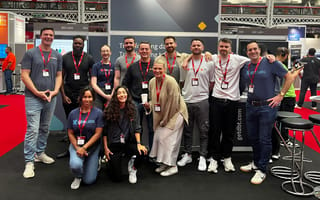Global Head of Solutions Architecture Jon “Natty” Natkins was representing dbt Labs at a summer industry conference when he had an experience that has stayed with him since.
It was the last day of the conference, when the hustle and bustle of connecting typically begins to slow down. But for Natkins, the day proved to be the opposite of quiet — as he spent five hours straight talking to customers.
“I had to physically walk away to get time even just to grab a drink of water, because so many people wanted to have a conversation about dbt Labs,” he recalled.
Natkins knows that a day like this may sound exhausting to some, but for him, it was nothing but fun. He believes it served as a microcosm of his overall experience at the company so far — reflecting its evolving prominence in the industry.
“There’s so much excitement, interest and curiosity about our products that it’s sometimes easy to forget that we’re still early on in the life of the company,” Natkins said.
Since its inception in 2016, when it was formerly known as Fishtown Analytics, the company has scaled significantly. When Natkins joined the organization in May 2021, he saw the number of team members grow from 100 to 300 in the span of one year.
Solutions Architect Victoria Perez Mola is one of many individuals who joined the company during that period of exponential growth. And among the many elements that define the work Mola and her peers accomplish, she considers a strong team spirit to be the biggest driver of their success.
“When people feel connected, supported and comfortable sharing their ideas, it creates a synergy that’s hard to beat,” she said.
Team culture is essential to driving progress at dbt Labs, especially when it comes to achieving goals. Associate Manager of Sales Development Caroline Wyse, whose team works closely with the solutions architecture team, knows how important it is to keep employees engaged and focused on the future.
As a leader, she strives to build a culture in which team members can rely on each other, find joy in others’ successes and take the initiative, all of which are seldom found in the competitive sales space.
“This structure isn’t a typical way of running a sales development representative team, but it’s what makes our team and dbt Labs unique in the best way,” Wyse said.
Whether preparing for a conference or developing internal frameworks to improve outcomes for customers, dbt Labs’ solutions architecture and sales teams rely on supportive cultures to pursue what’s possible in the analytics engineering realm.
EMPOWERING DATA PRACTITIONERS
dbt Labs’ mission is “to empower data practitioners to create and disseminate organizational knowledge.” The company’s open-source software enables any technologist who knows SQL to engineer, document and test data pipelines, therefore increasing their organizations’ ability to model and serve analytics.
Moments to Remember
Natkins’ busy day at last year’s conference is one he’ll never forget — yet it’s one of many moments that have defined his experience at dbt Labs.
Recently, his team helped launch a new companywide messaging framework, which represents a new go-to-market strategy that’s focused more heavily on the value of the company’s products. Natkins noted that the framework was largely created to develop a shared language that can be used internally to maintain alignment across teams.
“I, along with members of my team, participated by providing feedback, generating content and participating in workshops across the world,” he said.
“We participated by providing feedback, generating content and participating in workshops across the world.’’
Despite how well he and his peers worked together to bring the framework to fruition, Natkins shared, they encountered various challenges along the way — most glaringly, adoption. Considering the sales and solutions architecture org consists of about 100 people across the globe, it was difficult to ensure everyone adhered to the new framework.
To overcome this hurdle, Natkins explained, his team worked closely with partners in marketing, operations and other departments to ensure the framework was interwoven throughout all of their processes, content and internal discussions. So far, the framework has proven to be beneficial, having recently played a part in bringing a stalled sales deal to a close.
“That’s proof that this was a good investment of time and energy,” Natkins said.
While lending internal support is a defining feature of life at dbt Labs, employees also use their talents to benefit the wider industry. For instance, Wyse and her teammates played a large role in orchestrating Coalesce, the company’s annual analytics engineering conference, earlier this year.
Considering this year’s conference spanned three major cities across the globe, Wyse’s team had a lot of work to do — and not as much time as they needed to accomplish it all.
“We faced bandwidth issues: Although this event was a major focus for the team, we had many other initiatives going on at the same time,” she said. “With this in mind, it was crucial to tie together all data points to ensure we were executing at the highest level.”
To achieve optimal execution, Wyse ensured her team only discussed one initiative at a time during meetings, funneling the collective energy into that specific task. Meanwhile, she worked ahead on the next initiative so that the entire process would be completed once they got started on it. In taking these steps, Wyse shared, she learned how to be “a true filtering system for the team.”
Coalesce also gave Mola the chance to stretch her skills, as her team was assigned to create messaging to complement their demo assets during the conference. And while this undertaking was no simple feat, she believes it helped her grow in unexpected ways.
“I ended up connecting with people who I wouldn’t have otherwise had a chance to meet,” Mola said. “As a team player, I’m really proud of how we all came together to make this happen.”
Ownership Meets Evolution
Earlier in his career, Natkins believed that a great culture depended on whether or not a company had beer on tap in the office and a “work hard, play hard” mentality.
As he has grown professionally, so has his perception of cultural excellence.
“My understanding of culture has matured to more accurately be described by the type of people we choose to work with, what processes and systems we adopt to facilitate our chosen working styles and the intention we bring to how we build the organization,” Natkins said.
Believing that ownership is essential to embracing these elements, Natkins encourages his team members to bring up issues and propose solutions when possible. One of his main goals as a leader, he shared, is to enable his team to find new ways to evolve.
“I regularly ask myself, ‘How do I create an environment where we give people room to grow and give them opportunities to stretch themselves in the ways they want to?’” Natkins said.
“I regularly ask myself, ‘How do I create an environment where we give people room to grow and give them opportunities to stretch themselves in the ways they want to?’”
Sometimes, the best way to help team members grow is by getting them out of their comfort zone. To encourage her teammates to explore, Wyse aims to cultivate a culture of safety in which people feel empowered to share ideas and feedback.
For Wyse, it’s not enough to simply show her team members how to take the initiative. She considers it her responsibility to identify leadership skills in SDRs, as this encourages team members to continue to push themselves and fosters a sense of community.
“As the team has matured, this has been essential in keeping the team motivated and has allowed us to maintain a culture in which the team wants to collaborate, have fun and learn together,” Wyse said.
Connection is the backbone of culture on the solutions architecture and sales teams. And according to Mola, there are many ways in which she and her peers stay in touch with each other, whether that’s through brainstorming sessions, team updates or casual chats.
For Mola, having opportunities to engage with her peers is important not only because it drives teamwork, but also because she simply loves the people she gets to work with.
“Every person you’ll meet is incredibly bright, dedicated and genuinely kind,” she said. “This sparks a lot of interesting conversations that I’ve personally learned a lot from.”
A ‘ROSE,’ ‘THORN’ AND ‘GRATITUDE’
Natkins said he enjoys using “silly tools” to build culture on his team. For instance, at the start of every team meeting, he asks everyone to share a “rose” — a good thing that happened that week — a “thorn” — something that’s causing challenges for the team — and a “gratitude,” which involves thanking someone else on the call for helping in some way. “It’s a means for us all to get a sense of what’s going on in others’ lives,” Natkins explained. “These things aren’t always restricted to work, which lines up with our ‘We are human’ core value and promotes a collaborative environment.”
‘I Wouldn’t Give It Up for the World’
When Wyse joined dbt Labs as the company’s first global SDR in April 2021, she had no idea how much she would grow.
Having evolved tremendously over the past couple of years, she enjoys paying it forward and helping her teammates carve out their own career journeys: a hallmark of her team’s culture she appreciates most.
“As a team, we’re all hungry to grow and learn,” Wyse said.
“As a team, we’re all hungry to grow and learn.”
According to Mola, this eagerness to evolve can also be felt on her team, fueled by a shared passion for the company’s product. She believes this technological fervor lends itself to a culture that promotes progress, which in turn motivates everyone to show up to work with pride and take ownership every day.
“This drives us to innovate, collaborate and support the development of a great product,” Mola said.
Guided by this enthusiasm for their product, solutions architecture team members are continuously focused on delivering value to the company’s customers. Natkins believes this determination is fueled by an innate sense of curiosity as well as having the ability to support both peers and external stakeholders.
“It’s a highly rewarding role, because we get to work across many different parts of our organization and interface with many customers to help solve a wide variety of interesting technical challenges,” he said.
Out of all of the different elements that define his team’s work, Natkins considers customer interactions to be the highlight. For him, seeing the breadth of the company’s impact is enough to make anyone want to press the “Apply” button.
“I’m consistently amazed and energized by the companies that we’re able to converse and work with,” Natkins said. “I wouldn’t give it up for the world.”








